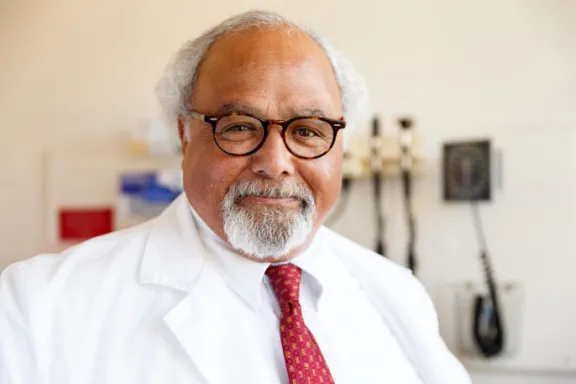
Q&A With Biden Advisor Dr. Eric Goosby, Part 4
In part 4 of Synapse's limited series, we ask UCSF Professor Dr. Eric Goosby, a member of President Joe Biden’s COVID-19 Advisory Board, to reflect on the 35 years of experience he's had working in the field of HIV/AIDS, including treating patients on the frontline when HIV/AIDS began to emerge in the 1980s.
Synapse: How do you think your work and experience with HIV/AIDs has prepared you to help advise on and fight the COVID-19 pandemic?
Dr. Goosby: With the HIV response — specifically, the Ryan White CARE Act in 1991, we were bringing federal dollars to municipalities, cities that were epicenter cities of the outbreak in those years. And we gave it to the cities — not just giving it to the city political leadership; we gave it to the mayor of the city. But we required that they set up a planning council. The planning council had to be composed of individuals who were first responders to HIV, but it also had to include people with political leadership of the Department of Health and the city — both public and private sector responses — who were infected or affected by HIV.
So the planning council forced a discussion around populations, resources, and who would or would not benefit from the response. And I think it was one of the biggest — going through, setting that up in 72 different cities in the United States. I got a deep appreciation of what is required to move a bureaucracy such as a city department of health into an accelerated response. So I think that’s why I was of interest to them.
I think that all of my work in sub-Saharan Africa, Southeast Asia, and Eastern Europe was the same type of work for countries. But it was taking and standing up delivery systems that weren’t there before for people who were largely marginalized in society, and who did not have natural access points to deliver the services and get the care. So a very similar dynamic, but instead of at a city level with Ryan White in the 90s in the United States, it was at a country level with HIV work, with PEPFAR work, and with all of the work after the late 90s.
Synapse: What are the most critical differences that you see between the AIDS epidemic and the COVID-19 pandemic?
Dr. Goosby: The half-lives — two days to fourteen days for COVID, versus ten years for HIV. TB has a somewhere-in-between half-life from exposure to active disease. That right there sets up all the responses that are possible, and I think issues of infectivity — how easily a virus can spread — is what saved HIV from, you know, just rapidly taking over the planet; it couldn’t. And it actually is hard to get infected by someone with HIV, or [for that someone] to give it to someone else. It’s not as easily done as with COVID.
But all to say that those differences also create an informing of what the effective response needs to be, and positions you to set up your surveillance system so that you’re getting the data to know if you’re working or not working. All of that came onboard to ministries of health, departments of health with TB back at the turn of the last century. They learned it once then, and forgot it. I think, to a large extent, that COVID has demanded that the entire country relearn how to respond to a viral invasion of a population — which, if you think about it, our medical delivery systems really have not done frequently enough to incorporate as a retained skillset. Like San Francisco — the last time they were dealing with something like this was in 1918, with the congestion in hospitals and deaths to go along with it. The swine flu was a stuttered start, and turned out be nothing.
So this is the biggest insult that we’ve seen since 1918, and our — I guess I would say — the decentralization of healthcare in general and, in particular, the rise of managed care has created a desolate area for the public health needs of a population. So, San Francisco — 80% insured. Kaiser, Sutter Health, United Health, Dignity Health — there’s only six big carriers in the Bay Area, in San Francisco. None of them wanted to talk to the department of health about testing or helping with homeless people with COVID, or contributing to the testing where most of the patients that are coming in aren’t insured.
Shouldn’t we do this jointly? They aren’t thinking, “we’re going to cover a public health threat,” so therefore, they’re not going to come into your meetings and talk to you about it. After their lawyers got aware of it and went through it, they realized that they were responsible for a public health response by accepting money every month, like two to three thousand, four thousand dollars for a family, but it’s the largest bill if you don’t have a mortgage that you’re putting out every month. And all they want to do — and this is just the tragedy of it all — is expand their profit margin, and that’s their first, second, and third thing that they think of when they make a decision.
And COVID completely exposed the folly of a decentralized healthcare system, and our city of San Francisco is small enough to see it. In places like L.A., you don’t appreciate — they don’t even see that the fact that so much of their population at risk isn’t insured; they didn’t think early on about what role the privately insured third party payers should contribute to the response. I think — you know, if you ask what the big lesson that I hope comes out of the COVID response is — it’s the appreciation of the danger that a decentralized healthcare system affords when you do have a common enemy or threat. Where all of your budgets that you have to mount, or pay for, a response — whatever it is — are in different spots under different processes, and never in expectation for a need to talk to each other. There’s no common role that they really see for each other.
And Biden is going to try to create — after we get through the first hundred days — a discussion that talks about how that decentralized healthcare system has negatively impacted us — especially minority communities and rural — and about are we not smart enough to figure this out, and rechallenge the decision that was made by society at large to allow a small number of people to own the United Health, or whatever the third party payer private sector healthcare delivery system is — Sutter Health in our town is a big one. How that decentralized decision creates a real threat that can hurt people or kill people if we don’t deal with it in another way — like, we’re going to deal with a common threat differently, and we’re going to create a process should one appear, where we can rapidly put it into a discussion that caps all of your budgets, all of your resources, or not.
And it’s a nightmare to think through about who’s responsible for what they stand up, who can get sued for what doesn’t work? All of those things are what mobilized the discussion, and we’ve been going through it over and over again in the United States, and over every state’s version of it. Each county has a version of it, with a health officer that’s responsible for the people who are showing up in the emergency rooms overflowing — they don’t turn to themselves to fix it; they turn to the local department of health as if they’ve got the resources to fix it, and they don’t because we’re so decentralized. So it’s this vicious circle of expectations not matched with budgets or human resources — the talent — to do it. And so here we sit. It’s been that way forever. This isn’t a new epiphany. What’s kind of current is that COVID showed us that we were pathetic in our ability to use this system to respond to that expanding threat.


